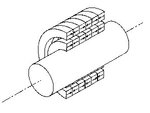leslie.liu88
Newbie level 3
- Joined
- Nov 24, 2010
- Messages
- 4
- Helped
- 0
- Reputation
- 0
- Reaction score
- 0
- Trophy points
- 1,281
- Location
- Shenzhen or Hongkong
- Activity points
- 1,307
 Magnetic bearings use magnetic fields to levitate spinning rotors and other components. Consequently there is no contact, essentially zero friction or drag, and no wear. LaunchPoint Technologies has used magnetic bearings in energy storage flywheels to enable ultra high-speed operation in a vacuum, in blood pumps to enhance reliability and biocompatibility, and in machine tool spindles for research and in micro-positioning.
Magnetic bearings use magnetic fields to levitate spinning rotors and other components. Consequently there is no contact, essentially zero friction or drag, and no wear. LaunchPoint Technologies has used magnetic bearings in energy storage flywheels to enable ultra high-speed operation in a vacuum, in blood pumps to enhance reliability and biocompatibility, and in machine tool spindles for research and in micro-positioning. LaunchPoint designs magnetic bearings using electromagnets and permanent magnets. Electromagnet-based bearings are referred to as Active Magnetic Bearings and typically have the form depicted in Figures 1 & 2. Coil currents are feedback controlled in order to accomplish stable levitation. This feedback control enables active damping of rotor vibration and very stiff support at the cost of sensors and the electronic control system. The maximum load of active magnetic bearings is limited by the saturation flux density of the iron used. A common rule of thumb for load is 100 psi times the cross sectional journal area in square inches. Thus for a 2 inch diameter bearing occupying 2 inches axially on a rotor, the peak load is approximately 400 lbs. The load can be increased significantly through design optimization and the use of cobalt-based ferrous materials.